Website sections:
- Services Provided
- IT Project Management
- Application Development
- Creativity Management
- Previous Work Experience
- Site Map
- Contact Information
Current section's content:
- Overview of Application Development
- Computer Application Development Process
- Subject Matters and Workflow Role in Application Development
- Website Layers of Qualities
- Page-Level Navigation Problems
- Increasing MS Access mdb File Operating Speed
- CRM Sales Software Selecting and Customization Processes
- Overview of Sales Software Selecting and Customization Articles
- What CRM Sales Software Is Right For You?
- Sales CRM Example

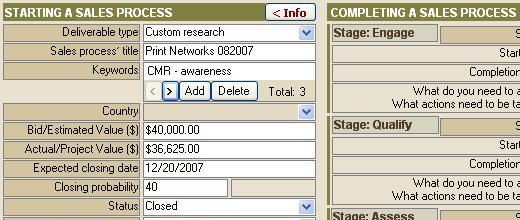
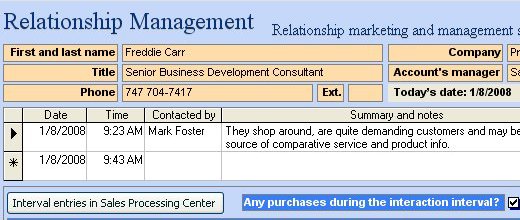
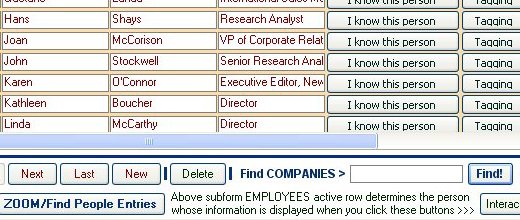
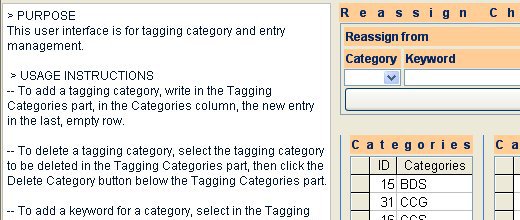
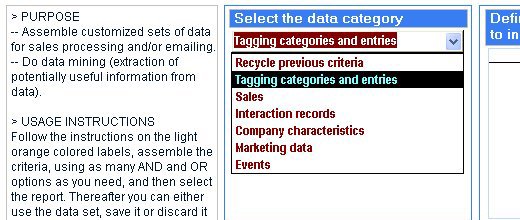
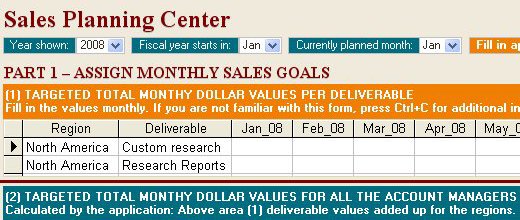
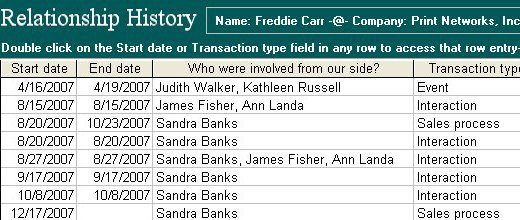
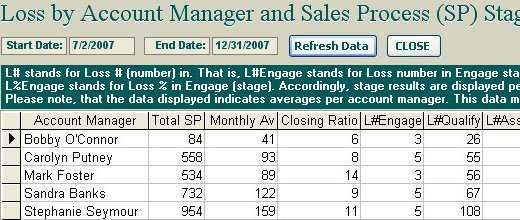
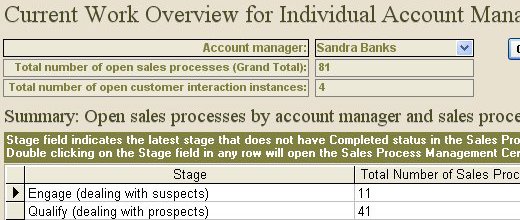
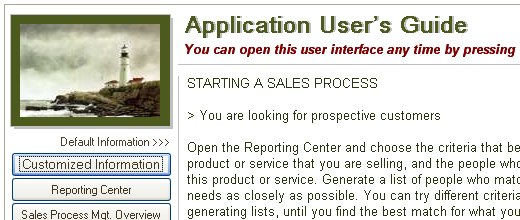
Sales CRM Example
SalesGetterTM CRM
Performance enhancing powerTM
Previous, related article in this subsection addresses sales CRM software selection and customization principles.
The sales CRM example application that is described here has been customized for a sales process. Despite of having a name (SalesGetter CRM) and a slogan, it is simply a prototype and an informative example of how a business process can be built into CRM sales software.
This prospecting, sales process and customer relationship management application can be further customized for individual companies needs, so that the end result is cost-effectively optimized for the best sales results.
The source information for this sales CRM example came from a market research and strategic consulting company. So, it is above all a market research and consulting company sales CRM application example.
Your company's sales process and the relevant needs may be different from the source information that was used for creating this example. So, your customized CRM sales software may look different, too. However, for the best results, it should contain built-in sales process tracking functionality, including prospecting related functionality, and it should track your company's customer relationship management areas, so that the business processes based information is brought together and is channeled through the application.
Contents
- User Interface and Functionality Descriptions
- What Technology and Software Should I Use?
- Overview
- Target Customer Base Description
- Highlights
- What Makes it Tick
- Sales Process Management in a Nutshell
User Interface and Functionality Descriptions
The source information for this sales CRM example came from a market research and strategic consulting company that sells primarily consulting services, industry forecasting services, research results and custom research services.
Your company's needs may differ and, accordingly, the functionality parts for the sales application that is customized for your company employees needs may differ as well.
- 1 Application Map (overview of the application)
- Account Management Tools
- 2 Reporting Center
- 3 Sales Processing Center
- 4 Info DimensionsTM
- Sales Management Tools
- 5 Sales Planning and Forecasting Tools
- 6 Sales Tracking and Progress Review Tools
- 7 Sales Troubleshooting, Data Mining and Reporting Tools
- Customer Relationship Management Tools
- 8 Interaction Records
- 9 Relationship Management
- 10 Data Management Tools
- 11 Unifying Company's Information Flow
- 12 Additional Tools: Users Guide and Other Support Tools
What Technology and Software Should I Use?
Even though the User Interface and Functionality Descriptions subsection above provides specific ideas for how SalesGetter CRM could be built, SalesGetter CRM is a concept, not a ready-to-use application.
Different relational database software and development approaches can be used for materializing this concept. The production environment application can use either SQL Server, MySQL or Oracle back end with a suitable front end. The selection of technology and software are important to the degree, that they support the implementation of the relevant concepts, company-specific business rules and the application users needs.
To put it differently, company's business processes + company specific business rules + application users needs should determine the technology and software that will be used, not the other way around.
Overview
SalesGetter CRM prospecting, sales process and customer relationship management application contains:
- Tools, that help to match products and services to customers
- Sales process management tools
- Functionality, that helps to increase the customer base
- Customer relationship management tools that help to maintain the existing customer base
- Sales planning, tracking and reporting tools for the sales management
- Tools for employees who need to enter data into the application
All tools have been built so, that they minimize the need for manual data entry, while increasing the ways data is used by the application and can be used by the application's users.
A well-developed, sufficiently customized computer application can increase user productivity. However, SalesGetter CRM goes way beyond that. The key component that will give the biggest boost to sales increase is computerized sales process management.
Sales process management is addressed below in a separate subsection.
If your company does not yet use sales process management together with a suitable, well developed and customized database application, then please do some research on the importance, and pros and cons, of using a sales process together with appropriately customized sales CRM software. Most likely you will see pretty soon, that when it comes to increasing sales, implementing this combination is a very safe bet.
Target Customer Base Description
- SalesGetter CRM primary target market are companies that:
- Depend largely on repeated sales to the same customers, can benefit from building longer-term relationships with the customers, but also want to grow their customer base continuously.
- Generate revenue primarily through a direct sales channel, rather than through indirect reseller or partner channels.
- Sales personnel engages primarily in consultative, value-based strategic selling, rather than operating in a highly transactional environment.
- Additionally, the application is very helpful in the following areas:
- Sales leadership either assigns quotas or otherwise plans for how much each of the account managers should sell in order to reach the company's objectives.
- Sales leadership or other company management members may need up-to-date sales progress reports, including reports on forecasted sales values versus actual values, and they need that information on demand, without having to contact the individual account managers.
- Account managers may depend on other employees input into the sales process.
- In some instances the account managers, or other employees who are involved in the sales process, may exchange substantial amounts of information with the prospect organization during the sales process.
- Either some or all of the company sales staff or other employees, who either directly or indirectly participate in the sales processes, are dispersed, but may need access to the sales process-related information.
- Account managers may use different resources and aides for moving the prospect through the sales process and may also need, on demand, up-to-date information that is relevant to add-on selling.
- SalesGetter CRM fits in very flexibly in the following areas:
- Sales cycle length may vary or may be fixed, and could be measured in days, or weeks or months.
- Deal values may vary or may be fixed, and could be measured in thousands, or in tens or hundreds of thousands of dollars.
- At any given time, individual account managers may work on any number of deals from a few to several hundred.
- Application user company may use either a strict and defined sales process, or a flexible sales process and may expect either relatively thorough or only minimum amounts of record keeping from the sales personnel.
Highlights
Have you ever rented movies from a video rental store? No matter how large the store is, the rental supply is limited, and despite of new movies coming in weekly, there are only so many titles that really match what you want to see.
That's the kind of situation that many companies account managers and other sales processionals face who depend largely on repeated sales to the same customers - each one of them has a limited universe of opportunities to work with.
Have you ever used an online movie rental service - Netflix, for example? The more tagging you do - that is, the more movies you rate using the 1 to 5 star rating scale - the more accurately can the system recommend you other movies to watch.
This system is not perfect, but all things considered, it works pretty well.
Instead of making recommendations on its own, SalesGetter CRM application described here provides results on demand that match the selected criteria. However, the basic principles are similar.
Netflix has some pretty advanced algorithms behind the recommendations. SalesGetter CRM customer selection functionality can be set up in a rather simple way, or it can be customized for specific user groups, using advanced functionality.
Whether you use existing customer data or rent brand new lists of potential customers data from the list rental companies, when using the SalesGetter CRM, the following applies:
- Account managers can continuously generate new sales processes with very little effort. In normal production environment, the account managers will be able to generate literally endless supplies of new sales opportunities that match their deliverables.
- Sales management can define at any given point who is handling what accounts, at what stages the accounts are, how many accounts are in particular process management stages, how effectively individual account managers are handling specific sales process management stages and specific types of customers, and what can be done to increase individual account managers performance and the total sales. Further, because more detailed information is available, sales forecasting accuracy increases as well.
- Sales process management can be done with very little effort as well. The application can be used so, that relatively few fields have to be filled in per sales process.
- The application is set up so that the sales process itself remains the same regardless of the deliverable type and other variables, but the amount of data that needs to be recorded can vary flexibly. Company's sales management can establish guidelines that help to determine how detailed information is needed and which fields need to be filled in.
What Makes it Tick
This application employs several concepts. Some of them are briefly addressed here.
- Having and using a sales process is an important part of what makes this application useful. This application's sales process is both flexible, so that it doesn't require much extra work from application users, and powerful enough, so that it helps to increase and track sales.
- Sales process is addressed in a separate subsection below.
- Data mining-based Reporting Center allows generating countless new prospect sets that match the products and services that the account managers currently sell.
- Tagging data through the data entry tools is recommended for the optimum results. Additionally, this application is set up so that the data tagging is updated through the application usage processes. So, the users can load untagged or partially tagged data into the application, and through the application usage processes the data will become increasingly tagged over time. Further, through application usage processes the data tagging will become increasingly accurate.
- Info Dimensions™ is a collection of data sets that can be reviewed one at the time and together provide a full view of the subject matter.
- Application's internal social network service helps the account managers to determine who in their company knows the prospective customer.
- Optionally, SalesGetter CRM can be integrated with the company's other applications, so that the relevant data is available for prospect screening purposes, and other applications and user groups can access selected sales-related data.
- As far as business applications are concerned, professional customization is the key to profitability. There is a big difference between having a business application - any vendor's business application - and having a business application that is professionally customized for your needs. Further, an application that costs little, but also does for you very little, may be a good investment only until better alternatives are not available.
- There are simple reasons for this. Your company needs to differentiate itself positively from the competition in order to be competitive. The more closely an application is configured to handle the tasks the way your company works, so that every step of the way the application helps to generate more value for you than you pay for it, the better investment it is.
Sales Process Management in a Nutshell
Sales process management addressed here works through:
- Defining the contact types.
- Defining the stages of the sales process.
- Channeling sufficient quantities of customer-related data through the application, so that the account managers can use the data for new business opportunity generating, effective support of individual sales instances, and management of new and existing customer relationships.
- Recording the sales process-related information through a computer application, but so, that the account managers need to record manually only minimum amounts of information.
- Using sales process-related information for monitoring, planning, forecasting and fine-tuning total sales, up-to-date progress, and individual account-managers work styles and task areas.
- The customer-related data that is inputted into the application can be only potentially relevant to the application owner company's sales activities. Through the application usage processes, the customer-related data is turned into sales process management related information, and the right data and information are filtered out and are used for turning potential customers into paying ones.
Contact Types
- Suspect - Name only; maybe just a company name. You only suspect that this "entity" is a target for your products or services.
- Relevant Sales Process Stage: Engage.
- Prospect - Suspect that has engaged with you in some way (either you contacted the suspect, or the suspect contacted you).
- Relevant Sales Process Stage: Qualify.
- Lead - Prospect for whom you have established a need for your product or service. The more immediate the need, the more hot the lead.
- Relevant Sales Process Stages: Assess, then Propose.
- Customer - Person who makes the buying decisions.
- Relevant Sales Process Stages: Close, Follow-up.
Here, depending on the business needs, we can also differentiate further, evaluating the participation in the sales process from the perspective of the buying process. Sales process and buying process are two different processes. The list below represents the overlap between these two processes. Identification and recording of this information for each person, who participates in the buying process, can be useful for future sales interactions:
- Customer - a person, who makes the buying decisions.
- Consumers - a person, who uses the product and/or service that you are selling.
- Buyers - a person, who approves the purchases or otherwise provides the money.
- Advisor - a person, who is not a customer, consumer or buyer, but participates in the buying process and advises others in the buying process.
- Silent Participant - a person, who is not a customer, consumer or buyer, participates in the buying process, but does not participate actively in the process when the sales person interacts with the group.
In business-to-business sales, suspect, prospect, lead, customer, consumer and buyer are usually more than one person, but any one person may have more than one role in the sales and buying processes.
Sales Process
Here is an example of a sales process. The sales process that is the best for your company may differ.
This sales process is applicable to a company that is selling relatively expensive and complex services (intangibles). Therefore, the sales process is characterized primarily by problem solving. To put it differently, prospective customers have problems that need to be solved profitably.
- Engage (dealing with suspects) - Turn suspects into prospects. Find a way to interact with the suspects (contacts) either through marketing or sales efforts.
- Qualify (dealing with prospects)
- What is the problem that we can help this prospect to solve? What are the prospect's needs and what are the wants? What are the prospect's primary objectives (that he or she needs to get out of this project)? What are your primary objectives regarding this prospect and this sale? How are you going to achieve these objectives? Does the prospects fit the overall target profile? Does the prospect's problem and needs fit together with what you can offer?
- Assess (dealing with leads)
- What are the key factors driving the lead's buying criteria? How immediate is the need, that is, how hot is the lead? Is the need clearly established? What are the specifics of the need? What are the main decision-making factors? How big is the budget? Do they understand your value proposition? Are they looking at competition? Are you dealing with a prospective customer, who can make the buying decision? Don't forget to address consumers and buyers needs, wants and concerns as well.
- Propose (still dealing with leads!) - Ask for the purchase or put in a bid; include all terms that can expedite the proposal.
- Close (dealing with the customers, but do not forget to address consumers and buyers needs, wants and concerns as well!) - Uncover and combat any possible objections, negotiate terms, and close the deal.
- Follow-up - Continue the process of uncovering and combating any possible objections; address buyers remorse. Ideally, Follow-up should turn into another Engage stage communication instance.
Using Sales Process Management For Results Improvement
Both the account managers and sales management can use the sales process management data for results improvement. Here are a few examples.
Assess the Total Sales
If an individual account manager's total sales figures are consistently high enough - well, that's probably a rainmaker. Let him or her do the job and provide all the support needed. As applicable, make sure that the account manager handles the appropriate higher end, demanding and/or more profitable deliverables.
If an individual account manager's total sales figures should be improved, look at the number of sales processes handled, the cost of individual sales processes and the closing ratio (addressed below). Can the account manager handle more deliverables and/or sales processes? If there is enough tagged data in the SalesGetter CRM, generating more suspects shouldn't be a problem. Should the average cost of the deliverables be higher?
Assess the Number of Sales Processes Handled
If the number of sales processes handled by most of the account managers is low, make sure that sufficient amounts of potential customer data is channeled through the SalesGetter CRM. Many companies are more than happy to furnish lists of potential customers with relevant data.
Further, people who work for your company probably already possess or deal and interact with lots of relevant information. Make sure, that the application is set up so, that the relevant information is channeled cost-effectively through the application. Be relentless about this: using the information correctly and consistently can make a huge difference in the bottom line. Further, as much as possible, this should be set up so, that different type of sales-related information that individual employees deal with, including the contacts, their interests, topics discussed, and so on, becomes through a system of tagging available to all the people who sell your company's products and services.
If the number of sales processes handled is high, but one or more account managers should be producing more value for the company, you may want to get more information about what both successful and unsuccessful account managers are doing during the different sales process management stages, so that you can compare this information. This is the scenario, where each account manager should fill in more than minimal amounts of information about what he or she does during the different sales process management stages.
Are there patterns, that indicate that the sales processes are breaking down at certain points more often than is expected? Does this characterize one or a few account manager's work, or is this relevant to most of the account managers work?
In the latter case, what sales process management, marketing, organizational, operations, or strategic changes are needed, in order to produce better results?
In the former case, perhaps an individual account manager is good at handling certain types of deliverables and less successful at handling others? Or, is the account manager good at handling certain types of customer base and less successful at handling other types of customers?
A lot of relevant information can be obtained from the sales process management reports.
Assess the Closing Ratio
If an individual account manager's closing ratio is low, maybe additional training will be helpful? There are numerous training methods available for increasing the closing ratio in any field of business.
Further, what are the closing ratios per product, service and customer type? If you identify the circumstances under which an individual account manager is a more successful closer, can you channel the workload so, that the account manager handles primarily these types of products, services and/or customers?
If the closing ratio is high, but the total sales is lower than needed, is it reasonable to expect that the account manager will handle more sales processes, or is his or her time usage already maxed out? If so, can the account manager concentrate more on big ticket, expensive sales processes that increase the total sales figures or are otherwise more profitable than the ones he or she handles now?
These are just some of the examples of how the Sales Process Management functionality and the rest of the SalesGetter CRM application can be used. For additional information on using SalesGetter CRM for sales results improvement, please see User Interface and Functionality Descriptions, Sales management tools, subsection below.
Beyond Sales Process Management
Most of SalesGetter CRM functionality focuses on sales process management. However, as applicable, SalesGetter CRM functionality can reach further. Here are a few definitions and the reasoning behind this approach.
Sales process - buyer and seller interactions, divided into stages that have identifiable characteristics that apply to most of the buyer and seller interactions that the company has.
Sales process management - activities of the sales professionals (for example, account managers) that relate to sales process.
Sales process life cycle - all activities, including interpersonal interactions, marketing, operations and other activities that can lead to and influence sales processes. Sales process life cycle can often start before the sales process - that is, buyer and seller interactions - start. For example, a company's analyst can have a discussion with an employee of another company. That discussion can later lead to a sales process. Similarly, in reality most successful sales processes tend to end with closing, and may have a brief follow-up process. Sales process life cycle, however, continues with customer experience, and, accordingly, can continue with the customer experience research.
Sales process life cycle management - activities, that focus on sales process life cycle administration.
Depending on the nature of an individual company's sales-related, recordable activities, SalesGetter CRM can be set up to capture sales process life cycle-related data, so that the company's management can evaluate the relevant information (as interpreted data) and alternatives from the cost effectiveness standpoint.
For example, lest say that a company's account managers (sales professionals) get leads primarily from the company's management members, analysts (who talk to the customers and refer them to the account managers as applicable), rental lists that come from different sources and are being fed through the sales application, special events that the company organizes, and from the existing customers.
When the sales application is set up so, that the lead generating related data is captured, it becomes easier to determine, which of the sources can be expected to produce more leads and so, that it will actually make a positive impact on the company's revenue streams and profitability.
Similarly, when the sales application is set up so, that the account managers record briefly post-sales customer experiences, and the company reacts to that information in an organized manner, more potential problems (that occur anyway) can be turned into opportunities. Further, systematically recording and then analyzing customer request that the company perhaps could, but currently is not able to fulfill, can help to generate new revenue streams.
SalesGetterTM CRM
Performance enhancing powerTM

